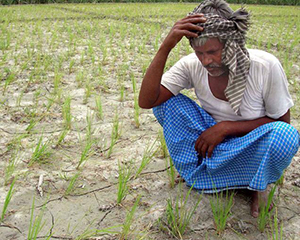I write these lines after having led an Inter Ministerial central team to the hailstorm affected districts of Maharashtra from 13-15 March. The twenty six members of my team, spread out in groups of two to three , traversed over seven thousand kilometers and made over a hundred ‘on – the –spot assessments ‘ of damage to standing crops which included wheat, maize, papaya, grape, pomegranate, onion, citrus and banana, among others. In village after village, we could see the fury of the gods ,the human agony and distress which was quite different from anything your columnist has seen in the aftermath of drought or floods. While all crop losses are bad, these were more acute, because the crops were ready for harvest, and in just a few days time, the crops would have yielded lakhs of rupees. So much had been planned by the families – marriage, college education, diversification, repayment of loans, a new purchase- and all this ‘vanished’ in just a span of a few minutes when hailstorm descended on these districts and left behind a white carpet of hail with tracts in Maharashtra looking as if these were snapshots of orchards in Kashmir or Himachal.
As the leader of the IMCT, one is expected to visit the affected areas and confirm the veracity of the statements made by the state government. Quite frankly, this is something you have take on face value after a few random checks- is it for example at all possible to check if 17 lakh hectares has suffered damage beyond 50% . The norms of relief under the National Disaster Relief Fund (NDRF) are also clearly laid down – ranging from Rs 4500/per hectare for rain fed lands to Rs 1200/hectare for perennial orchards , so on and so forth – for every identifiable and verifiable ‘episode’ ranging from damage to houses to death of poultry. The question is: does this in any way ‘compensate’ the farmer for the loss of investment, income, opportunity and most importantly, hope. True, the question can be asked – if it is so bad for the farmer, why does s/he not quit – to which the frank answer is: for want of a better option. Therefore more and more people are opting out of farming – but the other sectors are not growing at a pace to absorb those who wish to quit farming.
And after seeing the plight of the farmers who have lost almost everything, all I can say is that I am glad I work for the government, where an annual increment, assured promotion and dearness allowance linked to consumer price index is taken as a matter of right. With a lifelong pension and medical benefits for self and spouse, there can be no real cause for dissatisfaction. This is true for all those in the organized sector. Professionals like doctors, engineers, lawyers, architects, journalists, academics and media personnel – all guard their turf jealously, and continue to improve their incomes and entitlements year after year . We all seek comparisons with each other – but do we spare a thought for the farmer whose risks are becoming more pronounced in a market driven economy.
Let me explain this further. Under the peasant mode of production, the primary factor of production was his own labour. He planted his own seed, used his oxen to plough and made his own manure. In a year of drought, or when did not have a surplus, he suffered in silence, reduced his consumption to bare existence – but did not increase his indebtedness because he had not ‘borrowed’ from the market. In today’s context, the farmer has borrowed money for almost everything – from his tractor to fertilizer to micro irrigation equipment. As such, when monsoon plays havoc, and when markets do not give him a fair price for his inputs and labour, the distress is acute, especially when s/he compares that others are relatively insulated from these factors. This comparison is so sharp when s/he looks at those connected with input suppliers and others in the supply chain. The fertilizer dealers, including the co-operatives take ‘payment in advance’ before the material is handed over to the farmer. The aggregator /intermediary may not have the same margins- but he does not ‘lose’ anything, and the same is true for all others. The agriculture, relief and revenue department officials who prepare the estimates of loss are also insulated from the distress. The media has a field day trying to uncover the ‘human face’ of the tragedy, and pointing out that the central team members did not spend ‘adequate’ time to share the agony of the farmers. Leaders of all political parties also score ‘brownie points’ with regard to relief operations. Scientists write advisories on what can, or should be done on the farmer’s field. Everyone feels that they have done the best they could have, given the constraint of resources. And in any case how much can be done for the farmers- there are so many of them, and if they are suffering, there must be something wrong with the way they have organized their production. After all, unlike US or the EU, where the numbers are small, and therefore can be supported by the rest of the economy, how can the Indian farmer expect support when the economy is in a bad shape? Haven’t we already given the farmer enough freebies- power, water, fertilizer and credit subsidy, support prices and organizations like FCI and Nafed to pick up his surplus produce? Oh yes, we have done everything to help him, and there is sufficient material to respond to any query – in Parliament or outside on farmers’ welfare. Given the strength of these arguments, all one can say is: Thank God I am not a farmer!

